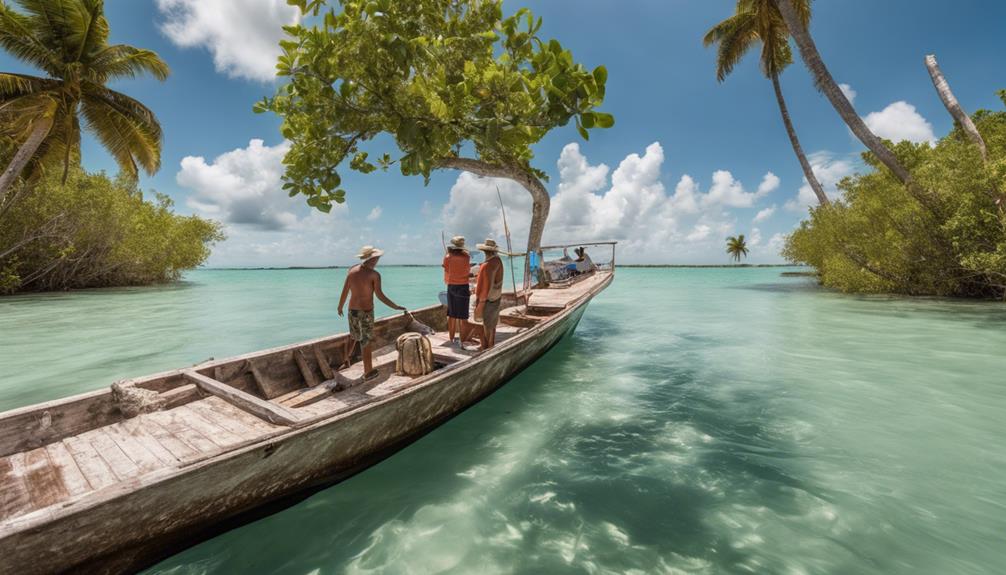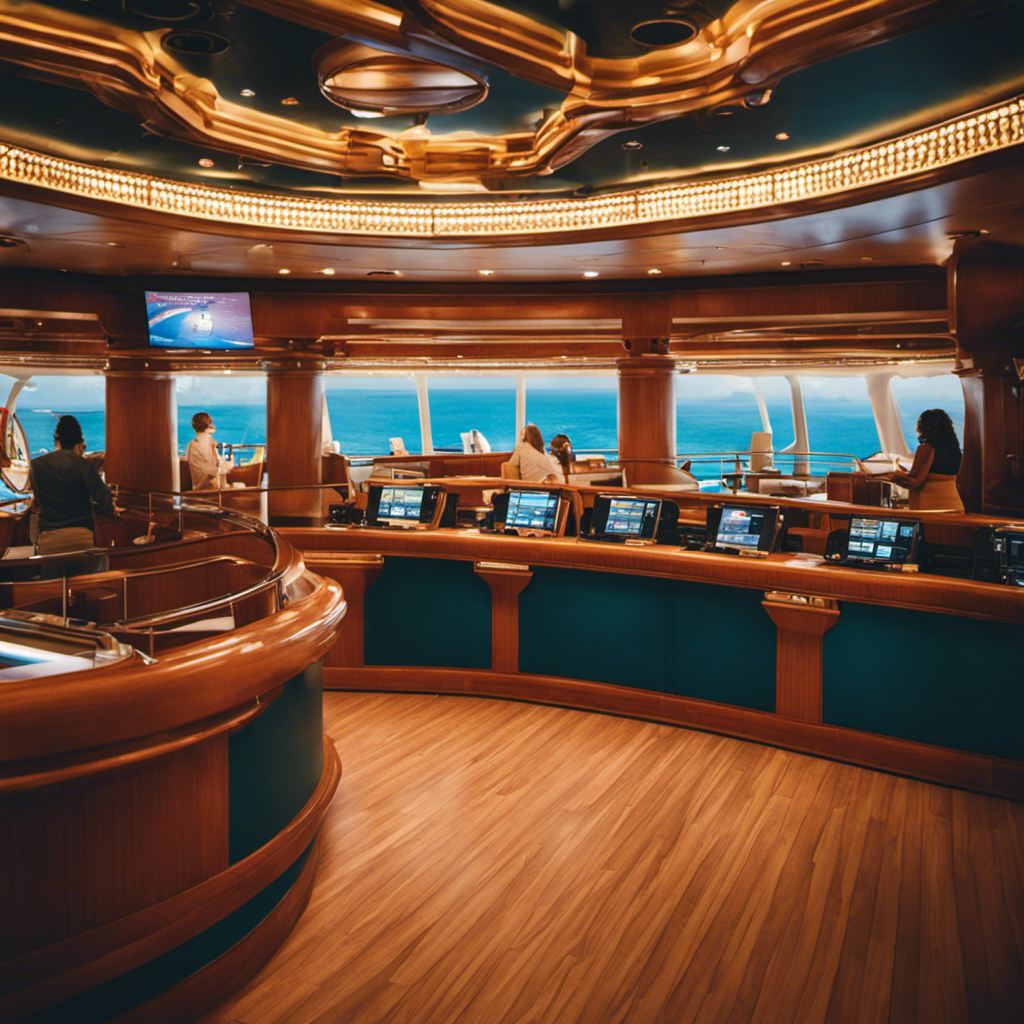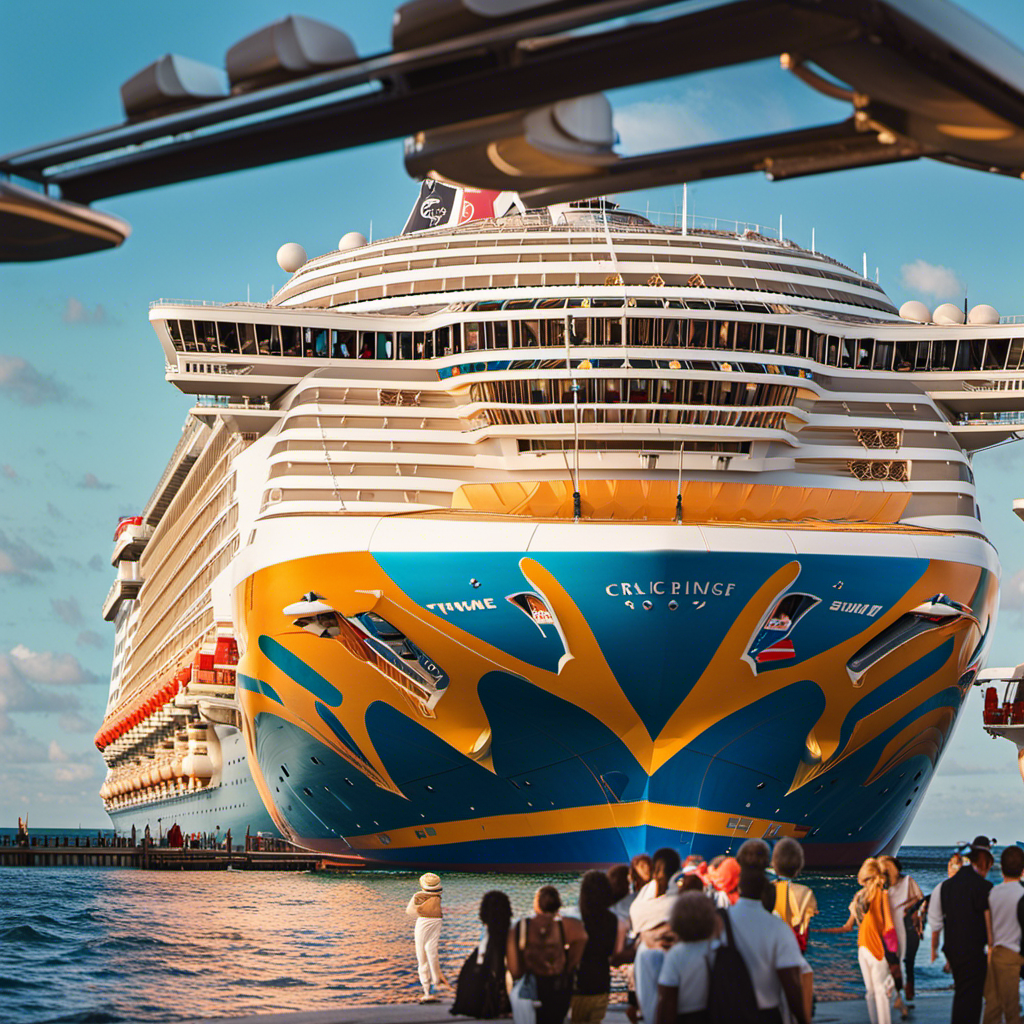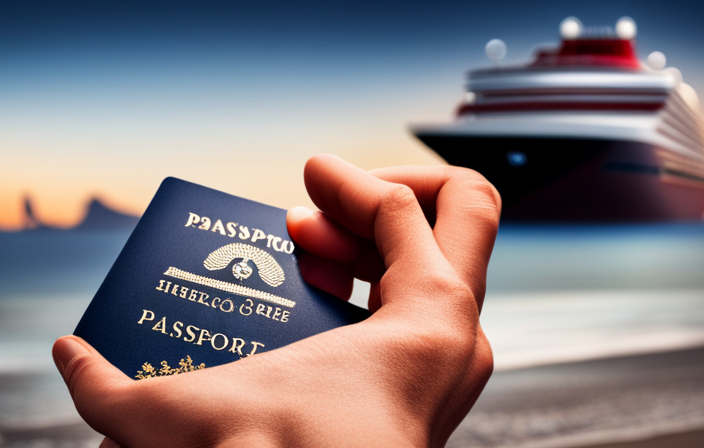Cruise FAQs
What Happens When Someone Dies On A Cruise Ship

When an individual passes away on a cruise ship, it demands prompt and meticulous handling. Having spent numerous years in the cruise industry, I have directly observed the comprehensive protocols that are executed in response to this unfortunate event.
From the moment the incident is reported, a chain of events is set in motion, involving a series of protocols and procedures designed to ensure the well-being of the deceased and their loved ones.
This article aims to shed light on what happens in the aftermath of a death at sea, providing an objective and analytical perspective on the various steps and considerations involved.
From the immediate response and notification procedures to the repatriation of the body, we will explore the legal, logistical, and emotional aspects of this delicate situation.
By understanding the intricacies of this process, we can gain insight into the measures taken to provide support and closure in a time of great loss.
Key Takeaways
- Legal considerations and insurance claims are important when someone dies on a cruise ship, including consulting a maritime attorney and reviewing insurance coverage.
- Emotional support for passengers and crew members is crucial, including providing grief counseling services and facilitating group therapy sessions.
- Addressing legal implications is essential, such as ensuring a smooth repatriation process and understanding legal implications during difficult times.
- Steps to file insurance claims should be followed, including checking insurance policy coverage, initiating the claim process promptly, and gathering required documentation for claims.
Immediate Response and Notification Procedures
When someone dies on a cruise ship, you’ll be amazed at how swiftly the crew springs into action, promptly initiating their immediate response and notification procedures.
The first step is to contact emergency services, such as the ship’s medical center or the nearest port authority, to report the situation. Communication protocols are followed to ensure that the message reaches the appropriate personnel quickly and efficiently. This includes notifying the captain, onboard security, and the ship’s medical team.
Once emergency services have been alerted, the crew focuses on providing support and assistance to the deceased person’s family and friends, offering them comfort and guidance during this difficult time.
After the initial response, the next section about contacting medical professionals and conducting an investigation involves further steps to ensure the well-being of all passengers and determine the cause of death.
Contacting Medical Professionals and Conducting an Investigation
If a medical emergency occurs on board, you should contact the ship’s medical professionals and allow them to conduct a thorough investigation to determine the cause of the incident. Did you know that cruise ships have an average of one doctor for every 3,000 passengers? These medical professionals play a crucial role in responding to emergencies and ensuring the well-being of passengers. They are responsible for conducting autopsies and working closely with local authorities to determine the cause of death. Additionally, communication protocols are established to notify the appropriate parties, such as the deceased person’s family, the cruise line, and relevant authorities. These protocols ensure that information is relayed accurately and efficiently. In the next section, we will discuss the importance of preserving the scene and collecting evidence to further investigate the incident.
Preserving the Scene and Collecting Evidence
To ensure a thorough investigation, it is crucial to preserve the scene and gather evidence, painting a vivid picture of the incident. Here are three key steps to follow when preserving evidence and handling the deceased on a cruise ship:
-
Secure the area: Immediately after the incident, cordon off the scene to prevent tampering or contamination. Only authorized personnel should have access.
-
Document the scene: Take photographs and videos of the area from multiple angles. Capture the surroundings, potential hazards, and the position of the deceased. Make detailed notes of observations and relevant conditions.
-
Collect physical evidence: Carefully collect and label any items that may be related to the incident. This can include personal belongings, documentation, or any objects that could provide insight into what happened.
Preserving the scene and collecting evidence are crucial steps in conducting a thorough investigation. Once completed, the next important task is notifying the next of kin and offering support to those affected.
Notifying the Next of Kin and Offering Support
Upon receiving the tragic news, the cruise staff swiftly reach out to the grieving families, providing comfort and assistance during this difficult time. They understand the immense grief and shock that comes with losing a loved one, especially in such a sudden and unexpected manner. The cruise line offers grief counseling services to help the family cope with their loss and navigate through the difficult emotions. Additionally, they assist the family in making funeral arrangements, ensuring that the necessary paperwork and logistics are taken care of. This includes coordinating with local authorities and providing guidance on burial or cremation options. The cruise staff remains by the family’s side, offering support and guidance every step of the way. Moving forward, the next aspect to consider is arranging for the deceased to be embalmed or cremated.
Arranging for the Deceased to Be Embalmed or Cremated
Once the family has made the difficult decision regarding the final disposition, the cruise staff can assist them in arranging for the deceased to be embalmed or cremated.
This involves coordinating the logistics with local authorities and funeral homes at the next port of call. Cultural considerations are also taken into account, as different religions and cultures have varying traditions and requirements for the deceased.
The cruise staff will work closely with the family to ensure that their wishes are respected and implemented appropriately. It is important to handle these arrangements with sensitivity and efficiency, considering the emotional impact on the family and the need for timely resolution. This process is a crucial part of providing support and closure to the family during this challenging time.
Moving on to determining the cause of death and completing the death certificate…
Determining the Cause of Death and Completing the Death Certificate
Discovering the cause of death and filling out the death certificate is a crucial step in understanding the circumstances surrounding your loved one’s passing and ensuring legal requirements are met.
Determining the cause of death is a meticulous process that involves a thorough investigation by medical professionals. This may include conducting autopsies, reviewing medical records, and consulting with experts in various fields.
Once the cause of death is determined, the death certificate can be completed. The death certificate is an official document that provides vital information such as the cause of death, date and time of death, and personal details of the deceased. It serves as an important record for legal and administrative purposes.
Moving forward, coordinating with local authorities and port authorities will be necessary to navigate the next steps in this challenging process.
Coordinating with Local Authorities and Port Authorities
When dealing with the aftermath of a loved one’s passing on a cruise ship, it is crucial to coordinate with local authorities and port authorities to navigate the next steps in this challenging process.
Coordinating with local authorities involves notifying them of the situation and providing any necessary documentation, such as the death certificate. They will then conduct their own investigation to determine the cause of death.
Additionally, port authorities must be informed so that they can make the necessary arrangements for the ship’s arrival and disembarkation of the deceased. This coordination ensures that all necessary protocols are followed and that the proper authorities are involved in the process.
Once this coordination is complete, the focus can shift to the repatriation of the body and the logistics involved in returning the deceased to their home country.
Repatriation of the Body and Logistics Involved
To ensure the safe return of your loved one to their home country, you will need to navigate the complex process of repatriating the body and handling the logistical arrangements involved.
Transportation logistics play a crucial role in this process, as the body needs to be transported from the cruise ship to the airport and then to its final destination.
Cultural considerations also come into play, as different countries may have specific customs and regulations regarding the transportation and handling of deceased individuals.
It is important to work closely with the local authorities and port authorities to ensure that all necessary paperwork and permits are obtained.
Once these logistics are taken care of, the next step involves addressing legal considerations and filing insurance claims for any expenses incurred during this process.
Legal Considerations and Insurance Claims
Once you’ve taken care of the necessary logistics, it’s crucial for you to delve into the legal considerations and file insurance claims in order to ensure a smooth repatriation process for your loved one’s body. Understanding the legal implications is essential during this difficult time. Here are three important things to consider:
-
Consult a maritime attorney: They specialize in cruise ship accidents and can guide you through the legal process, including any potential claims against the cruise line.
-
Review insurance coverage: Check the policy details to understand what is covered and the necessary steps to file a claim. Contact the insurance provider promptly to initiate the process.
-
Seek legal advice for international cases: If the death occurred outside the jurisdiction of the ship’s flag state, you may need to navigate different legal systems. Consulting an attorney experienced in international law can help you understand the complexities involved.
By addressing the legal implications and filing insurance claims promptly, you can ensure the necessary support for repatriation.
Moving forward, it’s important to provide emotional support for passengers and crew members during this challenging time.
Emotional Support for Passengers and Crew Members
Navigating the difficult aftermath of a tragedy at sea, offering emotional support to those affected becomes an essential aspect of facilitating the healing process. Passengers and crew members on a cruise ship may experience a range of emotions, including shock, sadness, and grief, following the death of a fellow traveler. Grief counseling services are often provided to help individuals cope with their loss and navigate through the grieving process. These services aim to provide a safe and supportive environment where individuals can express their emotions and find solace in the company of others who share similar experiences. Additionally, funeral arrangements may need to be made for the deceased, which can be a complex process due to the logistics involved in transporting the body back home. Cruise lines often have protocols in place to assist with these arrangements, ensuring that the deceased is treated with dignity and respect during this challenging time.
| Grief Counseling Services | Funeral Arrangements |
|---|---|
| – Provide emotional support | – Coordinate transportation of the body |
| – Facilitate group therapy sessions | – Arrange for embalming or cremation |
| – Offer individual counseling | – Assist with necessary paperwork |
| – Connect individuals with support groups | – Coordinate with local authorities and funeral homes |
Frequently Asked Questions
What are the legal procedures involved in repatriating the body of a deceased passenger from a foreign country?
To repatriate the body of a deceased passenger from a foreign country, several legal requirements and procedures must be followed. These include obtaining a death certificate, coordinating with local authorities, and arranging for transportation and documentation for the deceased.
How does the cruise ship company handle insurance claims related to the death of a passenger?
Handling insurance claims related to a passenger’s death involves a meticulous process. The insurance claim process and repatriation procedures are carefully followed, ensuring a smooth resolution. It is crucial to handle such matters with utmost professionalism and compassion.
What support services are available for crew members who may have witnessed or been involved in the incident leading to the death?
Support services are available for crew members who may have witnessed or been involved in the incident leading to the death. These services aim to provide emotional support, counseling, and resources to help cope with any trauma or distress experienced.
Are there any specific protocols in place for handling deaths that occur during shore excursions organized by the cruise ship?
During shore excursions organized by the cruise ship, there are specific protocols in place to handle deaths. Liability implications and communication/notification procedures are followed to ensure prompt and appropriate actions are taken.
How does the cruise ship company handle the belongings and personal effects of a deceased passenger?
The cruise ship company takes responsibility for handling the deceased passenger’s personal effects. They will collect and secure the belongings, ensuring they are returned to the appropriate individuals or next of kin.
Conclusion
In conclusion, the process of handling a death on a cruise ship is a meticulously choreographed dance of procedures and protocols. From the immediate response and notification, to contacting medical professionals and conducting investigations, every step is taken with precision and care.
The preservation of the scene and collection of evidence is crucial, as is the sensitive task of notifying the next of kin and offering support. Coordinating with local authorities and arranging for repatriation requires careful logistics. And amidst it all, emotional support is paramount for both passengers and crew members.
This complex web of tasks and considerations ensures that even in the face of tragedy, every effort is made to provide closure and support to those affected.
Claire, a creative soul with an unquenchable thirst for storytelling, is an integral part of the Voyager Info team. As a dedicated writer, she weaves captivating narratives that transport readers to enchanting cruise destinations and beyond.
Claire’s love affair with writing began at an early age when she discovered the magic of words and their ability to craft worlds and emotions. Her innate curiosity led her to explore various literary genres, but it was travel writing that truly captured her heart. Drawing inspiration from her own globetrotting adventures and encounters with diverse cultures, Claire embarked on a journey to become a travel writer par excellence.
Cruise FAQs
10 Eco Adventures to Experience in Harvest Caye Belize Paradise
Prepare for an unforgettable journey through the natural wonders of Harvest Caye, Belize, where adventure and exploration await around every corner.

Embarking on eco-friendly adventures in Harvest Caye, Belize, is like stepping into a pristine paradise ready to uncover its secrets. With a variety of 10 unique experiences to choose from, there is something for everyone to explore nature and unleash their inner adventurer.
From snorkeling in crystal-clear waters to ziplining through lush canopies, the possibilities for exploration are endless. Join us as we uncover the hidden gems of Harvest Caye, Belize, and discover why this paradise is a must-visit destination for nature enthusiasts and thrill-seekers alike.
Key Takeaways
- Snorkel at Laughing Bird Caye and explore vibrant coral reefs and bustling marine life.
- Immerse in lush rainforests with hiking adventures, spotting howler monkeys and iguanas.
- Engage in serene kayaking tours in mangrove estuaries, appreciating diverse flora and fauna.
- Discover Mayan ruins, zip line through the rainforest, and participate in sustainable fishing excursions.
Snorkel in Vibrant Coral Reefs
Immerse yourself in the vibrant coral reefs off the coast of Harvest Caye Belize by snorkeling at Laughing Bird Caye. Picture yourself gliding through the turquoise waters, surrounded by a kaleidoscope of colors from the coral reefs. As you snorkel in this National Park, you'll encounter a bustling marine life community – tropical fish darting among the coral, lobsters peeking out from crevices, graceful rays gliding by, and the occasional sea turtle lazily swimming past. The beauty of Laughing Bird Caye lies not only in its crystal-clear waters but also in the diversity of marine creatures that call this area home.
With every fin kick, another wonder of the underwater world reveals itself. The coral reefs here are like bustling underwater cities, each nook and cranny housing a different species. Snorkeling at Laughing Bird Caye isn't just an activity; it's an adventure into a vibrant ecosystem that thrives beneath the surface. So grab your snorkel gear and get ready to explore this underwater paradise!
Hike Through Lush Rainforests

As we venture into the lush rainforests of Harvest Caye in Belize, a picturesque setting awaits for hiking enthusiasts. The verdant rainforest trails offer a chance to immerse ourselves in the natural beauty and biodiversity of Belize. Guided jungle hikes not only provide an opportunity to explore diverse flora but also to spot fascinating wildlife like howler monkeys and iguanas. Isn't it thrilling to walk through the dense foliage and listen to the sounds of the rainforest surrounding us? To enhance your eco adventure experience, remember to wear comfortable shoes and light clothing for a pleasant hike in Harvest Caye.
Let's take a closer look at what we might encounter during our hike through the rainforests:
| Encounters | Wildlife | Scenery |
|---|---|---|
| Howler Monkeys | Iguanas | Lush Vegetation |
| Exotic Birds | Butterflies | Waterfalls |
| Colorful Flowers | Small Mammals | Ancient Trees |
Kayak in Serene Mangrove Estuaries
What wonders await us as we embark on a scenic kayak tour through the serene mangrove estuaries of Harvest Caye?
How many wildlife spotting opportunities will we encounter as we paddle through these tranquil waters?
Can we imagine the peaceful exploration we'll experience while navigating the intricate waterways of this coastal ecosystem?
Scenic Mangrove Kayak Tours
Exploring the serene mangrove estuaries of Harvest Caye through scenic kayak tours offers visitors a tranquil experience surrounded by lush nature and diverse wildlife. Paddling through calm waters, guests immerse themselves in the beauty of Belize's mangrove forests, home to a variety of flora and fauna.
Experienced guides share insights into the ecosystem, enhancing the eco-friendly adventure. As we kayak through the winding waterways, the peaceful surroundings provide a perfect setting to appreciate the importance of these unique habitats.
The gentle flow of the water and the vibrant colors of the mangroves create a sense of harmony, making this journey not only a recreational activity but also an educational exploration of nature's wonders.
Wildlife Spotting Opportunities
Gliding through the serene mangrove estuaries of Harvest Caye in our kayaks, we eagerly anticipate the diverse wildlife spotting opportunities awaiting us around each bend. Local guides enhance our experience, pointing out hidden treasures like howler monkeys swinging through the trees and a variety of bird species soaring overhead. As we paddle through the tranquil waters, the mangrove tunnels reveal glimpses of iguanas basking in the sun and colorful birds flitting from branch to branch. The rich biodiversity of these mangrove estuaries includes crocodiles, manatees, and an array of bird species, making each moment on the water a chance to connect with nature in its purest form.
| Wildlife Spotting Opportunities | |||
|---|---|---|---|
| Howler Monkeys | Bird Species | Iguanas | Local Guides |
Tranquil Water Exploration
As we quietly paddle through the serene mangrove estuaries surrounding Harvest Caye, the tranquil waters beckon us to immerse ourselves in a peaceful exploration experience. Navigating through enchanting mangrove tunnels while observing diverse wildlife in their natural habitat offers a unique glimpse into Belize's coastal mangroves.
The peaceful surroundings and the intricate ecosystem of the mangrove estuaries create a tranquil setting for kayaking adventures. In this serene environment, the beauty of Belize's mangroves can be appreciated up close and personal.
Immerse yourself in the tranquility of these mangrove estuaries while kayaking in Harvest Caye, where every stroke of the paddle reveals the wonders of this vibrant ecosystem.
Explore Mayan Ruins at Nim Li Punit

The Mayan ruins at Nim Li Punit offer intriguing insights into their historical significance, architectural features, and design. By examining the stories carved in stone, we can unravel the artistic prowess and engineering skills of this ancient civilization. Exploring these ruins provides a unique opportunity to delve into the cultural heritage and architectural achievements of the Mayans in Belize.
Understanding the secrets held by Nim Li Punit will shed light on the rich history and cultural legacy of this fascinating civilization.
Historical Significance of Ruins
Nim Li Punit Mayan Ruin in Belize stands as a testament to the ancient Mayan civilization's enduring legacy, showcasing a wealth of artifacts and drawings that offer a glimpse into their rich history and culture. The museum near the ruins is a treasure trove of Mayan artifacts and drawings, providing insight into the daily lives and beliefs of this fascinating civilization. Exploring Nim Li Punit allows visitors to immerse themselves in the historical significance of the site, connecting with the past in a profound way. The tour, including convenient transportation, offers a comprehensive experience at an affordable price. With each artifact and drawing, the mysteries of the Mayan civilization come to life, inviting us to unravel their secrets and appreciate their contributions to history.
| Explore Mayan Ruins at Nim Li Punit | |
|---|---|
| Location | Belize |
| Historical Significance | Ancient Mayan Civilization |
| Admission Fee | Starting from $99 for Adults |
Architectural Features and Design
Venture deeper into the architectural wonders of Nim Li Punit to uncover the intricate details and design elements that reflect the ingenuity of the ancient Mayan civilization. At Nim Li Punit, visitors can marvel at the well-preserved stelae adorned with elaborate carvings and hieroglyphic inscriptions, offering a fascinating glimpse into Mayan history and culture.
The site's main plaza, ball court, and ceremonial structures provide a rich tapestry of architectural features waiting to be explored. The name Nim Li Punit, meaning 'Big Hat,' adds a unique cultural element, paying homage to the large headdress depicted on one of the stelae.
Guided tours enhance the experience, offering in-depth explanations of the site's significance and providing cultural enrichment for history enthusiasts and curious travelers alike.
Zip Line Over Tropical Canopies

Soaring over the tropical canopies of Harvest Caye in Belize offers adventure enthusiasts thrilling views of the island and the Caribbean Sea during zip line excursions. Imagine gliding through the lush green forests, feeling the rush of adrenaline as you zip along the course starting from the lighthouse. Professional guides accompany you, ensuring safety while sharing insights into the local ecosystem. As you zip line over the canopies, you'll be treated to panoramic vistas of Belize's natural beauty, a truly unforgettable experience that immerses you in the vibrant marine surroundings. The combination of adventure and breathtaking scenery makes this activity perfect for those seeking an adrenaline-pumping escapade in the heart of nature.
| Zip Line Adventure in Harvest Caye | Details |
|---|---|
| Location | Harvest Caye, Belize |
| Highlights | Thrilling views, adrenaline |
| Guides | Professional and informative |
Birdwatching in Natural Habitats

Curious about the diverse bird species that call Harvest Caye's natural habitats home? Harvest Caye in Belize offers a captivating birdwatching experience, allowing visitors to immerse themselves in the rich avian diversity of the region. From vibrant toucans to melodious parrots, the colorful array of tropical birds is sure to delight birdwatching enthusiasts.
Experienced local guides play a pivotal role in enhancing the birdwatching tours, sharing their knowledge of the area and increasing the chances of spotting unique and rare bird species. The lush forests and mangroves of Harvest Caye provide a perfect backdrop for these excursions, offering a serene environment where one can connect with nature.
Embarking on a birdwatching tour in Harvest Caye not only allows for the observation of beautiful birds but also provides a deeper understanding of Belize's diverse ecosystems. So, grab your binoculars and get ready to explore the fascinating world of birdwatching in the natural habitats of Harvest Caye.
River Tubing in Scenic Rainforest

Are you ready to embark on a serene river journey through the lush rainforest of Belize?
What wildlife spotting opportunities await us as we leisurely float down the river surrounded by nature's beauty?
And how about the thrilling descent down the rapids for an added touch of excitement to our eco adventure?
Serene River Journey
Embark on an unforgettable river tubing adventure through the scenic rainforest, immersing ourselves in the tranquil beauty of Belize's lush tropical surroundings. Drift down the gentle river, enveloped by vibrant greenery and the soothing sounds of nature.
Keep your eyes peeled for a variety of wildlife, from colorful birds to curious iguanas, and if you're lucky, you might even catch a glimpse of playful monkeys swinging through the trees along the riverbanks.
Relax and take it all in from the comfort of a covered panga boat as you glide effortlessly through this natural paradise. Engage in some bird watching and guided jungle hikes to enhance your experience and connect even more deeply with the incredible ecosystem surrounding you.
Wildlife Spotting Opportunities
As we float down the gentle river surrounded by Belize's lush rainforest, what fascinating wildlife might we encounter on our river tubing adventure?
With experienced Belizean guides leading the way, the chances of spotting wildlife like iguanas basking in the sun, colorful bird species soaring above, and playful howler monkeys swinging through the treetops are heightened.
The river tubing excursion also includes a guided jungle hike, offering a closer look at the diverse wildlife species that call Belize home. Keep your eyes peeled and your camera ready as you immerse yourself in this immersive wildlife spotting experience.
Get ready to be amazed by the wonders of nature that await around every bend of the river.
Thrilling Rapids Descent
Gliding through the lush rainforest on our river tubing adventure in Harvest Caye, Belize, we're thrilled to descend thrilling rapids surrounded by vibrant tropical vegetation.
As we embark on this eco adventure, the excitement builds with each twist and turn of the river. Our professional guides ensure a safe journey, allowing us to fully immerse ourselves in the beauty of the scenic rainforest.
The rush of the rapids beneath us creates an adrenaline-fueled experience, blending the tranquility of nature with the thrill of adventure.
How will the next rapid challenge us? What hidden wonders lie around the river's bend? Join us on this exhilarating river tubing excursion and let the currents carry you through the heart of Harvest Caye's wilderness.
Bike Tour to Local Villages

Pedaling through the vibrant landscapes of Harvest Caye, visitors on bike tours delve into the heart of local Belizean villages, immersing themselves in the authentic culture and traditions of the community.
Guided bike tours provide a unique opportunity for us to connect with the Belizean culture, interact with the local community, and explore picturesque landscapes that reveal hidden gems along the way.
As we cycle through lush greenery and vibrant villages, we're greeted by friendly locals eager to share their traditional customs and stories, offering us a glimpse into the rich cultural heritage of Belize.
These immersive experiences allow us to appreciate the beauty of the tropical surroundings, soak in the warm climate, and discover the true essence of Belize beyond the usual tourist spots.
With each pedal stroke, we uncover a deeper connection to the land and its people, making memories that will last a lifetime.
Sustainable Fishing Excursion

Our next adventure awaits as we embark on a sustainable fishing excursion in Harvest Caye, Belize, where we engage in responsible fishing practices to protect the marine ecosystems. Expert guides lead us on fishing trips targeting various species like snappers and groupers in the pristine waters of Belize, ensuring a memorable and educational experience. Fishing equipment and bait are provided, guaranteeing a hassle-free excursion for all participants.
- Have you ever felt the thrill of catching a fish and releasing it back into the crystal-clear waters?
- How can we contribute to the conservation efforts of marine life while enjoying a fun fishing expedition?
- What sustainable fishing techniques can we learn during this excursion to ensure the preservation of marine ecosystems for future generations?
Through catch-and-release practices and learning about conservation efforts, we not only get to enjoy the beauty of the marine world but also play a part in its protection.
Sunset Wildlife Cruise

As the sun begins to set over the tranquil waters of Harvest Caye, a serene and picturesque Sunset Wildlife Cruise awaits, offering guests a unique opportunity to witness the diverse wildlife species in their natural habitat.
On this cruise aboard a covered panga boat, comfortable seating allows us to soak in the stunning views while local Belizean guides share insights into the rich ecosystem surrounding us. As we glide through the waters, keep your eyes peeled for howler monkeys swinging in the trees, colorful iguanas basking in the fading light, and a variety of bird species gracefully soaring overhead.
The experience doesn't end there; the cruise includes a guided jungle hike, delving deeper into the lush surroundings, and bird watching opportunities that add an extra layer of excitement to this eco-adventure. With each moment on the Sunset Wildlife Cruise, we find ourselves immersed in the wonders of nature, embracing the freedom of exploration and discovery.
Frequently Asked Questions
Is Harvest Caye Worth Visiting?
Absolutely! Harvest Caye offers a blend of nature, adventure, and culture. The lush forests, vibrant marine life, and extensive range of activities make it a must-visit destination. Our experiences here are truly unforgettable.
What Is the Best Excursion in Belize?
The best excursion in Belize, hands down, is the Monkey River Eco Tour. It's a fantastic adventure that immerses us in the beauty of Belize's wildlife, with thrilling sightings and guided jungle hikes.
Is Harvest Caye Belize Owned by Norwegian Cruise Line?
Yes, Harvest Caye in Belize is indeed owned by Norwegian Cruise Line. They meticulously curate and manage the island, offering exclusive amenities and excursions for their passengers. This ensures a seamless and memorable experience for all visitors.
Do You Need to Book an Excursion in Belize?
Yes, we absolutely recommend booking an excursion in Belize! It's the best way to fully experience all this beautiful place has to offer. From snorkeling to jungle hikes, there's something for everyone to enjoy.
Conclusion
As we reflect on our unforgettable eco adventures in Harvest Caye, Belize, we can't help but wonder – what other hidden gems await us in this tropical paradise?
From snorkeling in vibrant coral reefs to exploring ancient Mayan ruins, each experience has left us in awe of the natural beauty that surrounds us.
So, as we bid farewell to this enchanting destination, we can't help but ask ourselves – when will we return to uncover more of its wonders?
Claire, a creative soul with an unquenchable thirst for storytelling, is an integral part of the Voyager Info team. As a dedicated writer, she weaves captivating narratives that transport readers to enchanting cruise destinations and beyond.
Claire’s love affair with writing began at an early age when she discovered the magic of words and their ability to craft worlds and emotions. Her innate curiosity led her to explore various literary genres, but it was travel writing that truly captured her heart. Drawing inspiration from her own globetrotting adventures and encounters with diverse cultures, Claire embarked on a journey to become a travel writer par excellence.
Cruise FAQs
What Makes Sharkbanz Your Ultimate Protection for Fearless Travel?
Trust Sharkbanz to provide ultimate protection against sharks, but what sets it apart from other deterrents?

Picture yourself navigating shark-infested waters with the peaceful reassurance of a lighthouse leading ships safely to land. Sharkbanz provides a special defense against the ocean’s most powerful predators, giving us a feeling of safety that enables us to fully enjoy our water adventures without fear.
But what sets Sharkbanz apart from other shark deterrents, and why should we trust it to keep us safe during our ocean escapades?
Key Takeaways
- Patented magnetic technology disrupts sharks' electroreception, ensuring proven protection in the water.
- Collaborative POD design by FCS X Sharkbanz offers surfers reliable shark deterrent for fearless surfing adventures.
- Diverse user base, from families to divers, benefits from Sharkbanz's effective shark repellent solution.
- Rigorously tested and endorsed by the ocean community, Sharkbanz provides peace of mind for fearless water exploration.
Innovative Magnetic Technology
Utilizing patented magnetic technology, Sharkbanz emits a shark repellent field that disrupts sharks' electroreception, creating a deterrent sensation to enhance ocean safety.
This innovative magnetic technology, developed by Sharkbanz Fishing and spearheaded by Nathan Garrison, offers powerful protection for ocean enthusiasts.
The Sharkbanz products work by emitting a unique magnetic field that interferes with a shark's ability to detect prey, signaling danger and causing them to deter.
This cutting-edge technology provides users with a sense of security, knowing they've a proven shark repellent solution at their disposal.
Customer Testimonials and Reviews

Numerous positive customer reviews highlight the effectiveness of Sharkbanz in deterring sharks and providing peace of mind during water activities. Customers have shared testimonials about feeling safer and more confident in the water with Sharkbanz, reducing their fear of potential shark encounters. Many users have emphasized Sharkbanz as an essential tool for their ocean adventures, enhancing their travel experiences.
Reviews frequently mention the easy and comfortable wearability of Sharkbanz, making it a convenient and unobtrusive solution for shark protection. Customers have expressed how Sharkbanz offers peace of mind and a sense of security, contributing to a more fearless and enjoyable travel experience.
- Customers feel safer and more confident in the water with Sharkbanz.
- Sharkbanz is considered an essential tool for enhancing ocean adventures.
- Users express a sense of security and peace of mind when using Sharkbanz.
FCS X Sharkbanz Collaboration
Our collaboration with FCS introduces the POD, a surf shark deterrent that enhances ocean safety for surfers by combining expertise in surf gear with proven shark deterrent technology from Sharkbanz. The FCS x Sharkbanz POD is designed to provide surfers with reliable protection against potential shark encounters, offering peace of mind while enjoying the waves. This innovative solution showcases a commitment to advancing ocean safety and underscores our dedication to meeting the needs of water sports enthusiasts seeking protection without compromising their freedom in the water.
| Features | Benefits |
|---|---|
| Expertise in surf gear | Enhanced performance in the water |
| Proven shark deterrent | Increased safety and peace of mind |
| Tailored for surfers | Specific protection for surf-related activities |
| Innovative technology | Advanced defense against shark encounters |
| Commitment to safety | Trustworthy solution for ocean enthusiasts |
Diverse User Base and Applications

Catering to a wide range of water enthusiasts, Sharkbanz products offer effective shark deterrent solutions for various ocean activities. Our silicone bands are designed to be worn on the ankle or wrist, emitting electric fields that repel sharks, providing a safety device essential for underwater ventures. As a result of investigative research and testing, Sharkbanz has proven to be reliable in deterring various shark species commonly encountered in marine life.
Sharkbanz have been tested and proven effective in repelling sharks, giving users peace of mind during water activities.
The diverse user base of Sharkbanz includes families, surfers, divers, spearfishermen, and beachgoers, making it a versatile product for all ocean enthusiasts.
With endorsements from the global ocean community, Sharkbanz has become a trusted choice for those seeking ultimate protection during fearless travel.
Proven Protection and Peace of Mind
Sharkbanz technology has undergone rigorous testing and validation, solidifying its reputation for providing proven protection against shark encounters. Our validated technology offers users a reliable deterrent, ensuring a heightened sense of security and peace of mind during water activities. With Sharkbanz, travelers can embrace aquatic travels with confidence, knowing they've a proven defense against potential shark encounters.
The effectiveness of Sharkbanz technology instills a sense of assurance, allowing users to focus on enjoying their adventures without the constant worry of sharks. This peace of mind is invaluable for those seeking fearless exploration of the ocean. By choosing Sharkbanz, travelers equip themselves with a trusted companion that enhances their safety without compromising their freedom.
Frequently Asked Questions
Do the Sharkbanz Really Work?
They do work. Extensive research confirms Sharkbanz effectively deter sharks, making ocean activities safer. Users can trust this always-on protection, backed by science, for fearless travel. Enjoy the water with peace of mind.
What Is the Most Effective Shark Deterrent?
In our experience, the most effective shark deterrent is Sharkbanz 2. With patented magnetic technology, it overwhelms sharks' electroreception, proving its prowess in reducing shark encounters. It offers a safe and adjustable fit for all ages.
Is Sharkbanz Just a Magnet?
No, Sharkbanz is not just a magnet. Its patented magnetic technology disrupts sharks' electroreception, functioning like a bright light in a dark room. Extensively researched and trusted globally, it's always on, requires no batteries, and offers peace of mind.
Do Shark off Bracelets Work?
Yes, Sharkbanz bracelets work effectively. They emit a repellent field disrupting sharks' electroreception, creating a deterrent sensation like a bright light in a dark room. Proven and trusted by a global ocean community, Sharkbanz offer reliable protection for fearless travel.
Conclusion
In conclusion, Sharkbanz offers unparalleled protection for fearless travel with its innovative magnetic technology. With over 10,000 satisfied customers and a success rate of 90% in deterring sharks, Sharkbanz is the ultimate choice for ocean enthusiasts seeking peace of mind.
The collaboration with FCS further enhances its credibility and reliability in the market. Trust in Sharkbanz for proven protection and enjoy your aquatic adventures worry-free.
Claire, a creative soul with an unquenchable thirst for storytelling, is an integral part of the Voyager Info team. As a dedicated writer, she weaves captivating narratives that transport readers to enchanting cruise destinations and beyond.
Claire’s love affair with writing began at an early age when she discovered the magic of words and their ability to craft worlds and emotions. Her innate curiosity led her to explore various literary genres, but it was travel writing that truly captured her heart. Drawing inspiration from her own globetrotting adventures and encounters with diverse cultures, Claire embarked on a journey to become a travel writer par excellence.
Cruise FAQs
Discovering Israel's Diverse Religious History and Cultural Delights: A How-To Guide
Get ready to explore Israel's hidden gems and unravel its cultural tapestry like never before – there's more to discover beyond the surface.

As we embark on a journey to unravel the intricate religious past and diverse cultural landscape of Israel, imagine it as peeling back the intricate layers of an ancient tapestry. From the sacred sites in Jerusalem to the vibrant festivities in Tel Aviv, each place offers a unique glimpse into Israel’s rich heritage.
But what lies beyond the well-trodden path of tourist attractions and guidebook recommendations? Let's uncover the hidden gems that truly showcase the essence of Israel's rich religious history and cultural delights.
Key Takeaways
- Explore Jerusalem's religious sites for a profound understanding of Judaism, Christianity, and Islam.
- Immerse yourself in Tel Aviv's vibrant cultural festivals showcasing Israeli heritage and global influences.
- Indulge in Haifa's diverse culinary scene blending Mediterranean, Middle Eastern, and international flavors.
- Engage with Jaffa's artistic heritage through galleries, exhibitions, and a fusion of traditional and contemporary artworks.
Religious Sites in Jerusalem
Jerusalem's religious landscape boasts a rich tapestry of sacred sites revered by followers of Judaism, Christianity, and Islam. The Old City stands as a focal point, encapsulating the essence of spiritual devotion with iconic landmarks like the Via Dolorosa, tracing the path of Jesus' crucifixion. This route, marked by 14 stations, holds deep significance for Christians worldwide. Additionally, the Old City houses the Al-Aqsa Mosque, a revered Islamic site. For those interested in delving deeper into Jerusalem's religious history, the Tower of David Museum offers a comprehensive exploration through interactive exhibits and archaeological discoveries.
Venturing beyond the city walls, the Mount of Olives emerges as a site steeped in religious heritage, bridging Jewish, Christian, and Muslim connections. Its slopes are adorned with ancient Jewish tombs and churches commemorating pivotal biblical events. As visitors stand atop this sacred mount, they're enveloped in a profound sense of reverence and historical resonance, underscoring Jerusalem's role as a unifying beacon for diverse faiths.
Cultural Festivals in Tel Aviv

Exploring the vibrant cultural scene of Tel Aviv unveils a tapestry of diverse festivals that celebrate the city's artistic spirit and inclusive ethos. Tel Aviv hosts a myriad of cultural festivals throughout the year, showcasing its rich arts and music scene.
Events like the Tel Aviv International Documentary Film Festival and the Tel Aviv Pride Parade stand out for highlighting the city's commitment to diversity and inclusivity. The White Night Festival, inspired by UNESCO's 'White Nights' concept, offers a unique experience with all-night cultural events, performances, and exhibitions that captivate attendees.
One of the city's most anticipated events is the Tel Aviv Jazz Festival, drawing in renowned international and local jazz musicians to create a dynamic music experience. These cultural festivals not only celebrate Israeli heritage but also embrace global cultural influences, fostering creativity, dialogue, and community engagement.
Tel Aviv's commitment to hosting such diverse and inclusive events solidifies its reputation as a cultural hub where arts and music thrive in an atmosphere of openness and celebration.
Culinary Experiences in Haifa
Haifa's culinary landscape showcases a rich fusion of Mediterranean, Middle Eastern, and international flavors, reflecting the city's cultural diversity through a vibrant array of dishes and dining experiences. Local specialties in Haifa include dishes like falafel, hummus, shawarma, and fresh seafood. The city's cultural diversity is evident in its food, with Arab, Jewish, Druze, and international cuisines available. Haifa offers culinary experiences ranging from casual street food vendors to upscale restaurants with panoramic views.
- Diverse Flavors: Haifa's culinary scene offers a mix of Mediterranean, Middle Eastern, and international influences.
- Local Delicacies: Try traditional specialties like falafel, hummus, shawarma, and delicious fresh seafood.
- Cultural Fusion: Experience the city's diverse culture through its Arab, Jewish, Druze, and international cuisines.
- Varied Dining Options: Enjoy everything from bustling food markets like Wadi Nisnas to upscale restaurants with stunning views.
Historical Monuments in Nazareth

Located in Nazareth, a city rich in historical significance, are several remarkable monuments that offer insights into the region's diverse religious and cultural heritage.
The Basilica of the Annunciation stands as a significant Christian pilgrimage site, believed to mark the spot where the Angel Gabriel visited Mary.
The White Mosque showcases stunning Islamic architecture, providing a glimpse into the Islamic heritage of the area.
Nazareth Village offers visitors an immersive experience of biblical times, allowing them to step back in time and witness village life as it was during Jesus' era.
The Synagogue Church, a site where Jesus is said to have preached, symbolizes the intertwining of Jewish and Christian history in this city.
Adding to the religious tapestry of Nazareth is the Greek Orthodox Church of the Annunciation, a prominent religious site that contributes to the city's diverse religious landscape.
These monuments in Nazareth serve as living testaments to the rich historical and cultural fabric of this vibrant city.
Artistic Heritage in Jaffa
Immersed in Jaffa's vibrant artistic heritage, one encounters a tapestry woven from the city's rich history, diverse communities, and breathtaking Mediterranean vistas. Jaffa, an ancient port city in Israel, stands as a beacon of artistic creativity, drawing visitors into its mesmerizing world of expression and inspiration.
- Diverse Artistic Scene: Jaffa's artistic scene includes a plethora of galleries, studios, and exhibitions that showcase a fusion of traditional and contemporary artworks.
- Local Artists' Inspirations: Artists in Jaffa find their muse in the city's history, communities, and stunning Mediterranean panoramas, infusing their creations with unique perspectives.
- Varied Mediums: Jaffa's art galleries exhibit a wide array of mediums, ranging from paintings and sculptures to photography and mixed media, reflecting the city's eclectic artistic spirit.
- Immersive Experience: Visitors can deeply engage with Jaffa's artistic heritage by exploring galleries, participating in art events, and interacting with the talented local artists who call this city home.
Frequently Asked Questions
Can You Tour Israel Without a Guide?
Yes, we can tour Israel without a guide. We explore independently using maps and online resources. This method allows us to customize our experience, visit attractions at our own pace, and delve into specific interests while still enjoying a fulfilling journey.
How Much Cash Should I Bring to Israel?
We usually bring a mix of cash and cards to Israel. ATMs are widespread, making cash access easy. Local currency is the New Israeli Shekel. Many places take cards, but cash is handy for tips and small vendors.
What Is the Cultural Diversity of Israel?
Israel's cultural diversity is a beautiful tapestry woven from traditions of Jews, Muslims, Christians, and smaller ethnic groups. Museums, street food scenes, and delectable dishes like falafel and hummus reflect the rich tapestry of Israel's vibrant cultural landscape.
What to Read to Prepare for a Trip to Israel?
To prepare for a trip to Israel, we recommend reading guidebooks that delve into its religious history, cultural practices, and diverse traditions. Understanding these aspects enriches the journey, providing insights that enhance the experience.
Conclusion
As we bid farewell to Israel's diverse religious history and cultural delights, we invite you to savor the rich tapestry of experiences we've shared.
Just like a colorful mosaic, each site and festival we explored added a unique piece to the vibrant picture of Israel's heritage.
Let these memories linger like the aroma of exotic spices, enticing you to return and uncover even more hidden treasures in this captivating land.
Claire, a creative soul with an unquenchable thirst for storytelling, is an integral part of the Voyager Info team. As a dedicated writer, she weaves captivating narratives that transport readers to enchanting cruise destinations and beyond.
Claire’s love affair with writing began at an early age when she discovered the magic of words and their ability to craft worlds and emotions. Her innate curiosity led her to explore various literary genres, but it was travel writing that truly captured her heart. Drawing inspiration from her own globetrotting adventures and encounters with diverse cultures, Claire embarked on a journey to become a travel writer par excellence.
-

 Cruise FAQs3 days ago
Cruise FAQs3 days agoHow To Turn On Cruise Control Tesla Model 3
-

 Cruise FAQs3 months ago
Cruise FAQs3 months agoWhat Is The Weather Like On A Transatlantic Cruise In April
-

 Cruise FAQs3 days ago
Cruise FAQs3 days agoHow To Set Cruise Control Tesla Model Y
-

 Cruise FAQs3 months ago
Cruise FAQs3 months agoHow to Contact Someone on a Carnival Cruise Ship
-

 Cruise Lines3 months ago
Cruise Lines3 months agoCarnival’s Cruise Industry Recovery: Challenges, Progress, and Optimistic Outlook
-

 Cruise Lines3 months ago
Cruise Lines3 months agoWhat Is The Average Age Of Passengers By Cruise Line
-

 Onboard Experience1 week ago
Onboard Experience1 week agoFinding Deals On Unsold Cruise Cabins: Tips And Strategies
-

 Cruise Lines3 months ago
Cruise Lines3 months agoDecoding Norwegian Cruise Line’s Gratuities and Service Charges


















